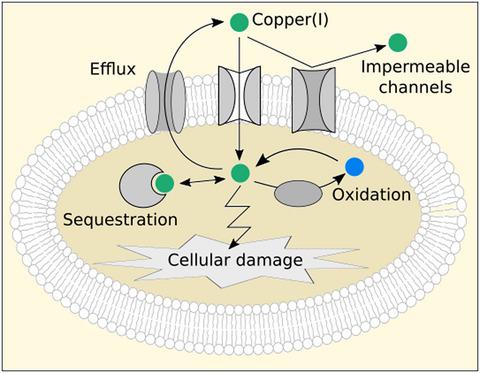当前位置:
X-MOL 学术
›
Mol. Microbiol.
›
论文详情
Our official English website, www.x-mol.net, welcomes your
feedback! (Note: you will need to create a separate account there.)
Copper tolerance in bacteria requires the activation of multiple accessory pathways.
Molecular Microbiology ( IF 2.6 ) Pub Date : 2020-04-23 , DOI: 10.1111/mmi.14522 Andrea Giachino 1 , Kevin J Waldron 1
Molecular Microbiology ( IF 2.6 ) Pub Date : 2020-04-23 , DOI: 10.1111/mmi.14522 Andrea Giachino 1 , Kevin J Waldron 1
Affiliation

|
Copper is a required micronutrient for bacteria and an essential cofactor for redox‐active cuproenzymes. Yet, excess copper is extremely toxic, and is exploited as a bacteriocide in medical and biotechnological applications and also by the mammalian immune system. To evade copper toxicity, bacteria not only control intracellular copper homeostasis, but they must also repair the damage caused by excess copper. In this review, we summarize the bacterial cell‐wide response to copper toxicity in Enterobacteria. Tapping into the abundant research data on two key organisms, Escherichia coli and Salmonella enterica, we show that copper resistance requires both the direct copper homeostatic response and also the indirect accessory pathways that deal with copper‐induced damage. Since patterns of copper response are conserved through the Proteobacteria, we propose a cell‐wide view of copper detoxification and copper tolerance that can be used to identify novel targets for copper‐based antibacterial therapeutics.
中文翻译:

细菌对铜的耐受性需要激活多种辅助途径。
铜是细菌必需的微量营养素,也是氧化还原活性铜酶的必要辅助因子。然而,过量的铜具有极强的毒性,在医学和生物技术应用以及哺乳动物的免疫系统中都被用作杀菌剂。为了逃避铜的毒性,细菌不仅控制细胞内铜的体内稳态,而且还必须修复由过量铜引起的破坏。在这篇综述中,我们总结了肠道细菌对铜毒性的细菌全细胞反应。充分利用了两种主要微生物(大肠杆菌和肠炎沙门氏菌)的丰富研究数据,我们表明,铜的抗性既需要直接的铜稳态反应,又需要处理铜引起的损害的间接辅助途径。由于铜的反应模式通过变形杆菌得以保留,因此我们提出了全细胞范围的铜排毒和铜耐受性视图,可用于确定基于铜的抗菌疗法的新靶标。
更新日期:2020-04-23
中文翻译:

细菌对铜的耐受性需要激活多种辅助途径。
铜是细菌必需的微量营养素,也是氧化还原活性铜酶的必要辅助因子。然而,过量的铜具有极强的毒性,在医学和生物技术应用以及哺乳动物的免疫系统中都被用作杀菌剂。为了逃避铜的毒性,细菌不仅控制细胞内铜的体内稳态,而且还必须修复由过量铜引起的破坏。在这篇综述中,我们总结了肠道细菌对铜毒性的细菌全细胞反应。充分利用了两种主要微生物(大肠杆菌和肠炎沙门氏菌)的丰富研究数据,我们表明,铜的抗性既需要直接的铜稳态反应,又需要处理铜引起的损害的间接辅助途径。由于铜的反应模式通过变形杆菌得以保留,因此我们提出了全细胞范围的铜排毒和铜耐受性视图,可用于确定基于铜的抗菌疗法的新靶标。











































 京公网安备 11010802027423号
京公网安备 11010802027423号